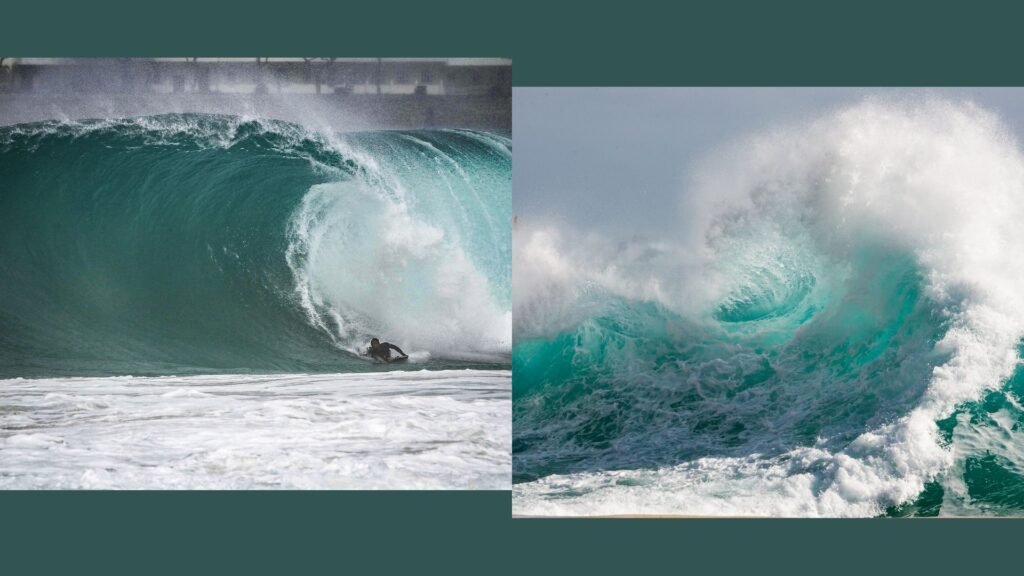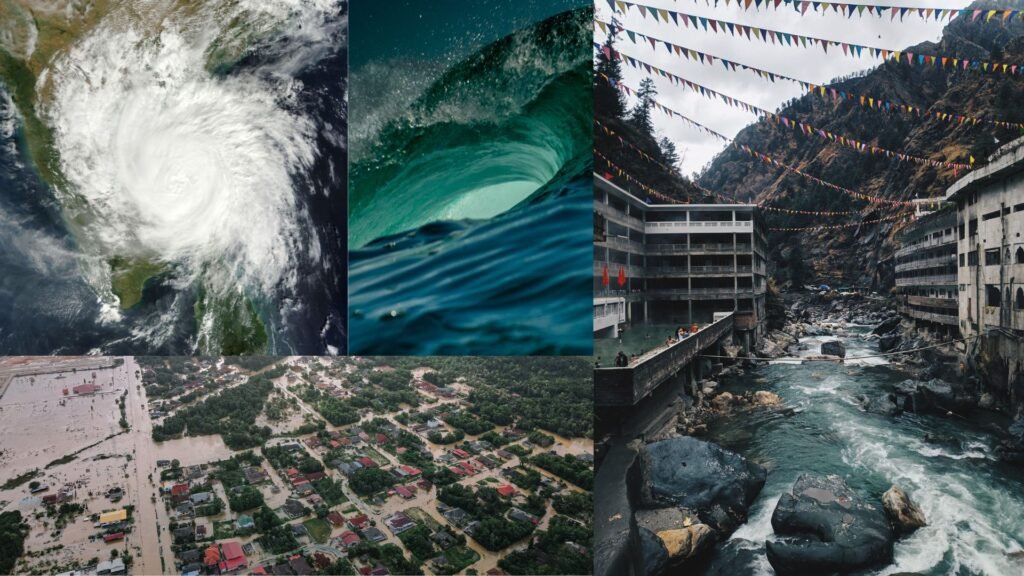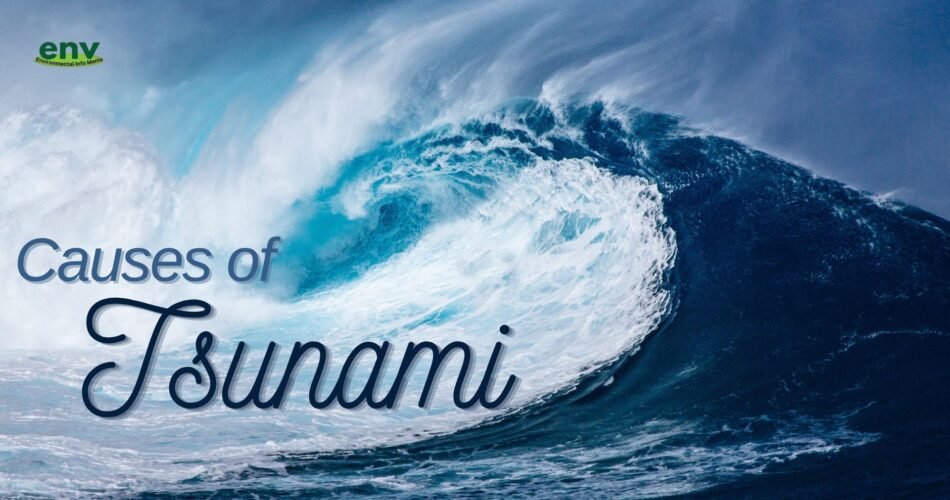This blog contains information about Causes, Impacts and Mitigation for Tsunami in detail. It also contains the Main Types of Tsunami. This also covers the Environmental Impacts, Human Impacts and Biodiversity Impact of Tsunamis. It is a complete bunch of information about Tsunami.
What is a Tsunami?
A tsunami is derived from the Japanese word “Tsu” that means harbor and another word “nami” that means wave. It is a series of huge ocean waves caused by high level disturbances of the ocean floor.
The waves of tsunami can travel across oceans at high speed of about 800 kilometers/hour resembled to a jet plane while having huge amount of energy. These waves are the most astonishing and destructive natural disasters on Earth. Their immense power can harm the entire communities, damage coastlines, and also leave long-lasting injury on human ecosystems and civilizations. While most of the time we mix them with tidal waves, tsunamis have distinct properties and these make them unmatched and dangerous. This blog dives into the logic behind tsunamis, their potential impacts, and conclusions that we get from some of the most deadliest tsunamis in history.
As the waves of tsunami travel through the deep ocean, their extent is often just some cm to a meter. This makes them nearly unrecognized. However, when these waves hit the coastal areas their speed reduces, and so the energy is compressed into waves called towering waves, sometimes touching heights that exceeds 30 meters. This phenomenon is called “wave shoaling.” It explains why they are so destructive when they arrive. Tsunami is an Extreme Impact of Climate Change in the form of Natural Disaster. This blog is all about Causes, Impacts and Mitigation for Tsunami.
Tidal Waves Vs Tsunami:
There are many differences between Tidal waves and Tsunami. Some of them are mentioned below:
Tidal Waves Tsunami
I. The major cause of Tidal waves is gravitational I. Tsunami are caused by Seismic waves i.e. Earthquake
force between Earth, Moon and Sun. or Volcanic Eruption.
II. These are predictable by observing regular rises II. Tsunami is unpredictable and can strike with little
and falls in the sea level. warming.
III. The water level is not very tall, so as the tidal III. The water level changes are forceful and rapid.
bores can reach to the significant heights.
IV. Example: The tides in the Bay of Fundy etc. IV. Example: The Indian Ocean Tsunami 2004 etc.
2. What are the Main Types of Tsunami?
Tsunami is one of the most dangerous and destructive Natural Disasters. Following are some of the Main Types of Tsunami:
i. Local Tsunami:
Local Tsunami is characterized by the disasters that occurs very near to the site of disturbance, i.e. Volcanic Eruptions, Earthquake or Landslide etc. They have short periods and High waves.
ii. Regional Tsunami:
These are the Tsunamis that cause damage 100 to 1000 km from the source of disturbance. They need more warning time than other types but the evacuation time is still not enough to save the people.
iii. Distant Tsunami:
They are also known as Ocean-wide and tele-tsunamis. These are more powerful than other tsunamis and they originate more than 1000 km away from landfall. They cause extensive and widespread destruction.
iv. Mega-tsunami:
Mega-tsunami is most extreme and dangerous form of Tsunami. It occurs because of the Extreme Activities such as Asteroid Impacts, Collapse of Volcanic Island and Massive Landslide.
v. Volcanic Tsunamis:
Volcanic Tsunamis are characterized by the major cause of Volcanic Eruption. These type of volcanoes only occur because of volcanic eruption. This type can be or minor or major extent according to the eruption.
vi. Meteotsunamis:
These are the tsunami that generates in the ocean due to atmospheric disturbances. This is one of the rear tsunami that occurs once in a long time interval.
These are the main Types of Tsunamis. All of them are different according to their Destruction, extent and distances from the site of disturbance. This blog is all about Causes, Impacts and Mitigation for Tsunami.

3. What are the Causes of Tsunami?
Tsunamis are triggered by sudden disturbances that displace large volumes of water. Here’s a detailed look at the primary causes:
Subduction Zones:
Tsunamis rises in subduction zones where one tectonic plate is pressed under another. The resistance between the plates and pressure build-up and result in a massive explosion of between the plates.
Elastic Rebound:
The sudden explosion of energy causes the seafloor to lift or go down by displacing the water above it. 2004 Indian Ocean tsunami is an example of this condition caused by a magnitude 9.1 earthquake away from the shore of Sumatra.
Volcanic Eruptions
High level volcanic eruptions can accelerates tsunamis by shifting water. In 1883 the Krakatoa eruption created waves over 40 meters high. It killed over 36,000 people. The collapse of Volcanic island can also trigger tsunami I.e. 2018 Anak Krakatau.
Submarine Landslides
The abrupt shifts in underwater sediments can shift large water volumes instantly. Most likely those that are near tectonic plate boundaries or volcanic regions. Example of 1998 Papua New Guinea tsunami was caused by an underwater landslide exaggerated by an earthquake.
Impacts of Asteroids
The extremely rare and large asteroid impacts in oceans could create destructive tsunamis. Scientists suggests the theory that such an event may have played a role to mass extinction events in the history of the Earth.
These were some of the Major Causes of Tsunamis. These are mostly triggered by Natural processes and Climate Change. This blog is all about Causes, Impacts and Recent Mitigation for Tsunami.
4. Environmental Impacts of Tsunamis
Tsunamis are not only destructive to human development but also to the environment. Their impacts include:
Erosion at the Coasts
Erosion is one of the most significant and immediate environmental impacts of tsunamis. Their huge force waves go striking the shoreline and also coming back to the ocean. This can take away vast amounts of soil, sand, vegetation, and even rocks. This leads to changes in coastal landscapes.
Wave Impact
Tsunamis carry huge amount of energy with waves hitting the coastline with high speed. The pure force shifts and takes away soil, sand, and rocks from shores and ridges.
Backwash Effect
Just after the starting of wave impact the water to the ocean in a strong backwash. dragging debris, sediment, and even large structures back with it. This scouring effect deepens the erosion.
Repeated Wave Action
Tsunamis mostly occur as a sequence of waves not a single wave. This repeated attack accelerates the erosion. As each consecutive wave further disturbs the shoreline.
Loss of Vegetation
The vegetation such as mangroves and dunes plays an important role in making a stable coastal soil. Tsunamis pull up this vegetation and eventually leave the coastline more available to future erosion.
Saltwater Intrusion
The waves of tsunami overburden freshwater system and makes soil and water saline. This makes the water inadequate for irrigation and drinking. The recovery of this condition can take years or decades.
Habitat Destruction
The Tsunamis are destructive natural events that damage ecosystems and destroy homes of biodiversity present on land and in water. The energy of the waves when combined with the devastating effects of flooding and debris can permanently alter landscapes. It may wipe out whole habitats, and disturb ecosystems that may take years to be restored.
Direct Wave Impact
Tsunami may destroy on-shore vegetation pull up trees and damages sensitive habitats. The habitats present near the sea such as mangroves, wetlands, and coral reefs are badly effected. These ecosystems are often located in regions at sea level that makes them vulnerable.
Inundation by Saltwater
Floods that originates from tsunamis introduces seawater into freshwater living systems such as rivers, lakes, and groundwater. This salinization is fatal for plants and animals that cannot live in high salinity. This entirely alter their habitat.
Sediments and Debris
The waves of tsunami takes up many sediments in the ocean, debris and land. Extreme Sedimentation can be extremely destructive for coral reefs, seagrasses, and other habitats.
Pollution
The natural disasters like Tsunamis damage livelihood and infrastructure, it also cause extreme environmental pollution. The extreme force of the waves with the floods introduce toxic substances into natural living systems.
Wreckage
The huge waves wash away buildings, vehicles, boats, and other infrastructure. It intrude them into debris that is carried into rivers, oceans, and surrounding regions. These things include wood, metal, plastics, and concrete. They contribute to high level contamination in effected areas.
Chemical Spills
Industrial areas, chemical storage facilities, and gas stations are damages during tsunamis. The Tsunami waves can spill toxic substances like petroleum, fertilizers, and industrial chemicals into the surroundings.
Sewage Overflow
The tsunami cause the overflow in sewer systems. This cause raw sewage water to mix with flood. This contamination highly affects freshwater sources, soil, and the ocean. Leads to create public health risks and also harming marine ecosystems.
Litter of Marine Environment
Huge masses of floating debris comes out to sea that contributes to marine pollution. Materials like Plastics and non-biodegradable materials etc. can persist in the ocean for a long time.
Runoff from Agriculture
When flood hit agricultural land, fertilizers, pesticides, and also the animal waste spread into surrounding water reservoirs. This runoff with overloaded nutrients can disturb aquatic ecosystems and lead to algal blooms.
These are the major Environmental Impacts of Tsunami. These are extremely harmful for Environment and cast extreme impacts on the Natural Systems and cause great loss of nature. All of these impacts are related to Climate Change. This blog is all about Causes, Impacts and Mitigation of Tsunami in detail.
5. What are the Impacts of Tsunami on Human Life?
Human life effects at a great extent because of Tsunami. The people living in the coastal regions many face many issues like Economic loss, Life loss, Injuries etc. These Impacts are explained below:
Death and Injury:
Thousands can die in minutes due to drowning or being struck by debris. The 2004 Indian Ocean tsunami killed over 230,000 people so it can cause a lot of life loss and can injure people in great ratios. Tsunami is one of the most Fatal Natural Disaster that has occurred in the world.
Displacement:
Survivors are often left homeless, with limited access to food, water, and medical care. The coastal populations are destroyed due to destruction of property, homes and other essential resources. This can be extremely vulnerable condition for the people surviving Tsunami.
Economic Loss:
Infrastructure like roads, bridges, and buildings is destroyed, causing billions in damages and also hampering recovery efforts. These infrastructures are built along years and decades and so they can destroy with Natural Disasters like Tsunami within hours and days.
All of these impacts disturbs human life at a great extent. We cannot control Tsunami, but we can devise Mitigation Measures before its occurrence to reduce the damage. We can consider Tsunami as the Extreme Impacts of Climate Change. This blog is all about Causes, Impacts and Mitigation for Tsunami.
6. What are the Impacts of Tsunami on Biodiversity?
The entire ecosystems can collapse by the tsunami waves. An example is mangrove forests that act as breeding ground for marine life. It can also lead to Species extinction. If the recovery efforts fails, the habitat loss is too severe to overcome.
Animal Impacts
Many terrestrial and marine animals die in the waves or lose their living environment. The species at the shore like turtles, crabs, and seabirds are especially vulnerable. Amazingly, some animals have intense sensory conception that cause them to be alert for the on way tsunami, giving them time to leave the place.
Another Aspect of Tsunami:
Tsunamis are overwhelmingly harmful due to their destructive nature. However, in rare cases, they can have long-term benefits:
Geological Changes:
These can create new landforms or rearrange coastlines. This may provide homes for various species. Tsunami also contributes in making geological changes into the Earth. These changes may be extremely useful for the Environmental conditions.
Nutrient Redistribution:
Floodwaters can distribute nutrients across coastal and marine environments, potentially supporting plant growth. Tsunami play a great role in redistributing the nutrients along a large geographical area and so this is beneficial for the Environment.
Despite these minor benefits, the damage caused to human lives, infrastructure, and ecosystems far outweighs any positives. This is all the Impacts of Climate Change and structural changes of the Earth that cause Tsunami.
7. What are some Major Tsunami Case Studies?
Following are some of the Major Case Studies of Tsunami that occurred in the world:
2004 Indian Ocean Tsunami aftermath
Cause: 9.1 earthquake
Effected: 14 countries i.e. Indonesia, Sri Lanka, and India.
Deaths: 230,000 and millions were displaced.
2011 Tōhoku Japan
Cause: 9.0 magnitude earthquake
Height: 40 meters. Fukushima nuclear disaster
Deaths: 20,000
1960 Valdivia Tsunami at Chile
Cause: magnitude 9.5
Effected: Chile, Hawaii, Japan, and also Philippines
Deaths: 1000s
1755 Lisbon Earthquake and Tsunami
Cause: Powerful earthquake
Effected: Lisbon, Portugal, Spain, and Morocco.
Deaths: 60,000
2011 Pacific Ocean Tsunami
Cause: 9.0-9.1 magnitude megathrust Earthquake
Effected: Japan, Hawaii and U.S. West Coast.
Deaths: 19,759
They are great examples of destruction and life loss as a Result of a Natural Disaster. This blog is all about Causes, Impacts and also Mitigation of Tsunami.
8. How to Mitigate the Impacts of Tsunami?
Mitigation is basically the act of reducing the negative impacts of any natural disasters. Following are some mitigations of Tsunami:
Consider Natural Warning Signs:
Natural Warning signs for tsunami include animal behavior, unusual currents in ocean, sea receding, ground shaking etc. These signs are true predictors of upcoming disasters. We should never avoid these signs and we should consider them before its too late.
Tsunami Early Warning System:
Development of efficient early warning systems for tsunami can be useful for mitigating its impacts. These systems include Sea-level monitoring and other such precautions. Early warning would help in early evacuation of people from the areas at risk of tsunami.
Seawalls and Barriers:
If the seawalls and barriers will be installed in the tsunami prone areas or the areas at risk of disaster, it will reduce the damage. The infrastructure, population and the resources will be safe from great damage. This will be a useful mitigation strategy.
Coastal Forests:
Forests that are in the coastal areas are Coastal Forests. These forests protects the populations and resources of coastal areas. The old trees in the coastal areas act as a shield against the water related disasters including Tsunami.
Land-use Planning:
Land-use planning is the science that is utilized to decide the use of land per unit area. This is compulsory for mitigating the impacts of the any disaster at the sea shore. Land-use plan can be helpful for the suitable utilization of the land at coastal areas.
Community Education and Awareness:
The awareness of the community play a great role in dealing with the damage of any disaster. If people will be trained for tsunami emergencies, they will be able to protect lives and resources by taking account of the Early warnings.
Policy and Technology:
We should work for establishing policies supported with the technology in order to make tsunamis less damaging. This can be extremely helpful in mitigation of such natural disasters.
Seismic Hazard Mapping:
Seismic Hazard Mapping is a technique to map the upcoming seismic activities in order to stay alert for future disasters. These include Earthquakes, volcanic eruptions etc. that may lead to Tsunamis.
These are the ways or strategies to mitigate Tsunami Impacts. This blog is all about Tsunami Causes, Impacts and Mitigation.
Climate Change and Future Risks of Tsunami:
As climate change triggers glacier melt and increases the chances of extreme weather, the risk of tsunamis may increase in the areas that were left unharmed in the past. Melting of ice caps, rising sea-level, and more chances of landslides may contribute to tsunamis that have climate as their cause.

9. Conclusion:
Tsunamis are a threatening reminder of massive power of nature and our susceptibility. The causes of tsunami have roots in the energetic processes of Earth. Their impacts reach to all forms of life, leaving behind destruction and loss. With the advances in knowledge and technology, tsunamis make them a intimidating challenge. As communities worldwide attempts to improve resilience, the importance of environmental conservation, education, and disaster preparedness cannot be overstated. So, to prevent Tsunami and other such Natural Disasters we should work on the prevention of Climate Change to avoid Extreme Climatic Conditions.
To learn more, Click the links below:


Comments